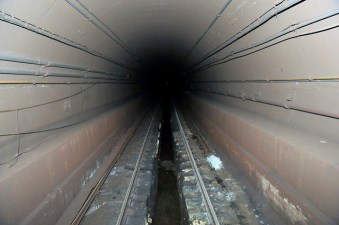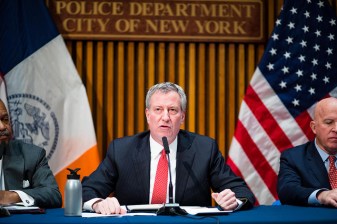A Weekend Subway Ride With Robert Moses

I entered a turnstile in the Financial District on Saturday, bound for the Upper West Side. The 2 train was running on the east side and the 3 wasn’t running at all below 14th Street. So I went instead to the A and the C platform. The C train wasn’t running, period.
With the C train out and the 2 and 3 trains FUBAR, the A train, when it finally came, was absolutely packed. Any New Yorker except for — I’m guessing here — the richest 1% and the poorest 1%, is familiar with this condition during rush hour, but hopes to avoid it on the weekend. But not this weekend. I had one person in each armpit, while, confounding the laws of physics, I was simultaneously in someone else’s armpit. Each stop took a half an hour to get through because the people were blocking the doors open as they crammed into the cars. Someone near me was asking her traveling companion if there wasn’t some kind of maximum allowable limit to the number of people who could be crammed into a subway car. Packed as it was, the train frequently crept through the tunnels at a snail’s pace because there were workers repairing the tracks or platforms. When I got off at 59th Street, the platforms were being torn up as the floors were being replaced.
It is nice to see investment in mass transit, but somehow, one wishes this investment wasn’t quite so … thorough.
Just as I was considering cursing the MTA for the comprehensiveness of its maintenance operations, I was reminded of who to blame. Above the heads of all these people standing in the aisles, there was a 1938 photograph of the smirking face of a young Robert Moses, standing, arms folded, in front of a giant map of New York’s arterial roadways (not the photo above). It was part of an advertisement for an exhibition (third item) celebrating Moses, the dawn of the automobile age, and the 70th anniversary of the opening of the Triborough Bridge.
Now I remembered where to direct my angst over the sorry conditions underground. By systematically starving mass transit to pay for his grandiose automobile projects, the subways were on life support by the time Moses died in 1981. A year later, the MTA began its mammoth program to bring the stations and tracks back into a "state of good repair." More than two decades later, this program continues, creating the need for weekend service curtailments just as the city is bursting at the seams with new residents.
Cursing the MTA would have been misdirected. It is doing what it has to do. Work needed to bring the system up to a state of good repair is ultimately a good thing. But a crash program to restore the system wouldn’t be necessary today if the planners of generation ago hadn’t been so certain that the automobile was the answer to all transportation problems. And one busy Saturday underground, there was Robert Moses, staring down at a new generation of subway sardines, still mocking us.
I’m very familiar with the automobile age. Please, don’t make me celebrate it.



